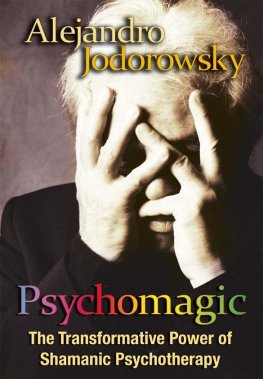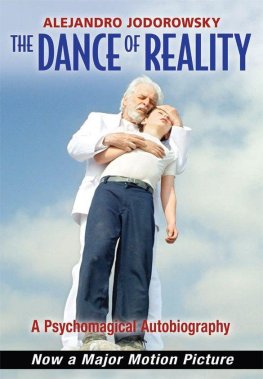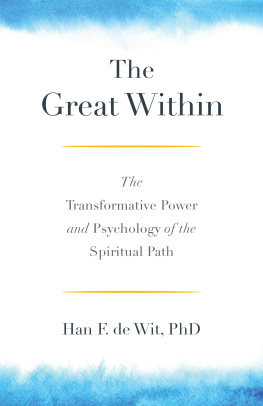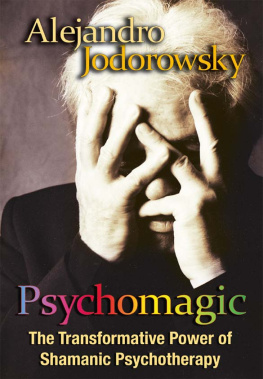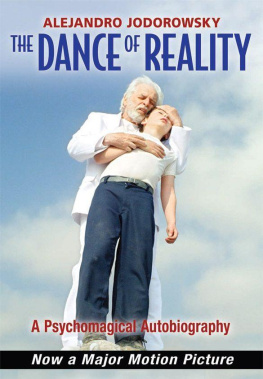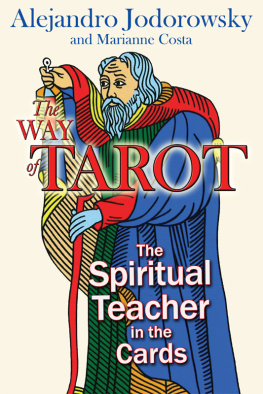Jodorowsky, Alejandro - Psychomagic: The Transformative Power of Shamanic Psychotherapy
Here you can read online Jodorowsky, Alejandro - Psychomagic: The Transformative Power of Shamanic Psychotherapy full text of the book (entire story) in english for free. Download pdf and epub, get meaning, cover and reviews about this ebook. year: 2010, publisher: Inner Traditions Bear & Company, genre: History. Description of the work, (preface) as well as reviews are available. Best literature library LitArk.com created for fans of good reading and offers a wide selection of genres:
Romance novel
Science fiction
Adventure
Detective
Science
History
Home and family
Prose
Art
Politics
Computer
Non-fiction
Religion
Business
Children
Humor
Choose a favorite category and find really read worthwhile books. Enjoy immersion in the world of imagination, feel the emotions of the characters or learn something new for yourself, make an fascinating discovery.

- Book:Psychomagic: The Transformative Power of Shamanic Psychotherapy
- Author:
- Publisher:Inner Traditions Bear & Company
- Genre:
- Year:2010
- Rating:3 / 5
- Favourites:Add to favourites
- Your mark:
- 60
- 1
- 2
- 3
- 4
- 5
Psychomagic: The Transformative Power of Shamanic Psychotherapy: summary, description and annotation
We offer to read an annotation, description, summary or preface (depends on what the author of the book "Psychomagic: The Transformative Power of Shamanic Psychotherapy" wrote himself). If you haven't found the necessary information about the book — write in the comments, we will try to find it.
Jodorowsky, Alejandro: author's other books
Who wrote Psychomagic: The Transformative Power of Shamanic Psychotherapy? Find out the surname, the name of the author of the book and a list of all author's works by series.
Psychomagic: The Transformative Power of Shamanic Psychotherapy — read online for free the complete book (whole text) full work
Below is the text of the book, divided by pages. System saving the place of the last page read, allows you to conveniently read the book "Psychomagic: The Transformative Power of Shamanic Psychotherapy" online for free, without having to search again every time where you left off. Put a bookmark, and you can go to the page where you finished reading at any time.
Font size:
Interval:
Bookmark:

Psychomagic

Jodorowsky is a brilliant, wise, gentle, and cunning wizard with tremendous depth of imagination and crystalline insight into the human condition. His work is a source of inspiration for me and for many of the most important and innovative artists of our time. Psychomagic is necessary reading for all who long to shock the world into awakening and remembrance of what has always been and what is still to come.
DANIEL PINCHBECK, AUTHOR OF2012: THE RETURN OF QUETZALCOATL
Currently there are books that have become essential to winnow out established ideas and open new horizons. The texts brought together here have that special ability to contemplate old problems from perspectives that were not thought to exist.
EL MUNDO
Alejandro Jodorowsky seamlessly and effortlessly weaves together the worlds of art, the confined social structure, and things we can only touch with an open heart and mind.
ERYKAH BADU, ARTIST/ALCHEMIST
The best movie director ever!
MARILYN MANSON
CONTENTS
Title Page
Epigraph
Prologue
PART ONE

PSYCHOMAGIC: SKETCHES OF A PANIC THERAPY
A Portrait of the Artist in Panic Character by Interviewer Gilles Farcet
ONEThe Poetic Act
TWOThe Theatrical Act
SACRAMENTAL MELODRAMA
THREEThe Oneiric Act
FOURThe Magic Act
FIVEThe Psychomagic Act
SIXExamples of Psychomagic Acts
SEVENPsychomagic Letters
EIGHTFrom Imagination to Power
PART TWO

LESSONS FOR MUTANTS
A Synthesis of Experiences by Interviewer Javier Esteban
NINEKeys to the Soul
TENThe Trail of Life
ELEVENThe Invisible Bridge
TWELVEVisions
THIRTEENThe Art of Healing
FOURTEENUnderstanding Life
PART THREE

AN ACCELERATED COURSE IN CREATIVITY
Introduction
HISTORY OF THE IMAGINARY
LEAVING OUR PRISONS
BE CREATIVE
FIFTEENExercises for the Imagination
GROW
EXPAND
SHINE
BE WEIGHTLESS
THE GAME OF TIME AND SPACE
BLESS THE WORLD
DISSOLVE THE I
BE A DOT
FINE ARTS
HAVE TALENT
DRAW
SCULPT
FASHION DESIGN
THE RAINBOW
YOUR SPACE
FREE YOURSELF FROM LANGUAGE
SIXTEENTechniques for the Imagination
SEVENTEENTherapeutic Applications
Footnotes
About the Author
About Inner Traditions Bear & Company
Copyright & Permissions
PROLOGUE
Having lived many years in Mexico City, I had the opportunity to study the methods of those called witches or folk healers. They are legion. Every neighborhood has one. Rising up in the heart of the city is the great Sonora market, which sells exclusively magic products: colored candles, dissected fish shaped like the devil, images of saints, medicinal plants, blessed soaps, tarots, charms, plaster sculptures of the Virgin of Guadalupe turned into skeletons, and so on. In some back rooms, plunged in semidarkness, women, each with a triangle painted on her forehead, rub bunches of herbs and holy water on those who come for consultations; they practice cleansing the body and the aura . . . Professional doctors, being faithful sons of the university, despise these practices. According to them, medicine is a science. They would like to find a precise, ideal remedy for every illness, with each treatment distinct from all others. They want medicine to be one official method, with no variations, to be applied to patients who are treated only as bodies. None of them proposes to cure the soul. To folk healers, on the other hand, medicine is an art.
It is easier for the unconscious to understand dream language than rational language. From a certain point of view, illnesses are dreams, messages that reveal unresolved problems. Folk healers develop personal techniques with great creativity: ceremonies, spells, strange medicines such as caf au lait laxatives, rusty screw infusions, mashed potato sanitary napkins, animal excrement tablets, or moth eggs. Some have more imagination or talent than others, but all, if consulted with faith, are useful. They speak to the primitive and superstitious individual, whom we all carry inside.
Watching these popular therapists operate, often performing miracles using the honorable tricks of a skilled magician, I came up with the notion of the sacred trap. For the extraordinary to occur, it is necessary for the sick to firmly believe in the possibility of a cure and to accept the existence of miracles. To be successful, the healer is forced to employ tricks during the first meetings, which convince her clients that material reality obeys that of the spirit. Once the sacred trap tricks the person seeking consultation, he experiences an interior transformation that permits him to capture the world by way of the intuition rather than by reason. This is the only way that a true miracle can take place.
But I ask myself: without the sacred trap of this artistic therapy, could a person without faith be cured? On the other hand, although the rational mind guides each individual, can we say that anyone lacks faith? At every moment, the capacity of the unconscious exceeds the limits of our reason, whether by way of dreams or by involuntarily acts. With that in mind, shouldnt there be a way to make the unconscious behave voluntarily, like an ally?
One incident that occurred in one of my psychogenealogy courses gave me an idea: When I described the causes of neurosis, a medical student suddenly fell on the floor twisting with painful spasms. It seemed like an epileptic seizure. Amid general panic, without anyone knowing how to help him, I went over to the afflicted student andwithout knowing why and with a great deal of troubleI removed his wedding band from the ring finger of his left hand. Immediately, he calmed down. I realized that the objects that surround and accompany us form part of the language of the unconscious. In this way, putting a ring on a person can imprison him, while taking the ring away can relieve him . . .
Another experience, which had very revealing results: When my son Adan was six months old, he was ill with a very bad case of bronchitis. A doctor friend of mine, an herbalist, prescribed drops of essential oils. My ex-wife Valrie, Adans mother, was to pour thirty drops into his mouth three times a day. She quickly complained that the boy was not getting better.
I told her, The problem is you dont believe in the remedy. What religion were you brought up in?
Like every MexicanCatholic!
Then we are going to incorporate faith into these drops. Each time you administer them, say an Our Father.
So thats how Valrie did it, and Adan recovered quickly.
After that, I beganvery prudentlyto incorporate this method in my tarot readings. When a client asked me how to solve a problem, I would prescribe what I called Psychomagic. Why didnt I just call it magic?
For a primitive therapy to function, the witch doctor, supported by the spiritual superstitions of the patient, must maintain a mystery, present himself as the possessor of superhuman powers obtained through a secret initiation and relying on divine and supernatural allies to bring about a cure. The remedies they provide are mysterious to their clients, and the actions they recommend are intended to be performed without knowing why. In Psychomagic, to the contrary, we need the individuals understanding instead of his superstitious beliefs. The patient should know the reason for each of his actions. The psychomagician makes the transition from witch doctor to adviser. Using psychomagic prescriptions, the patient becomes his own healer.
Next pageFont size:
Interval:
Bookmark:
Similar books «Psychomagic: The Transformative Power of Shamanic Psychotherapy»
Look at similar books to Psychomagic: The Transformative Power of Shamanic Psychotherapy. We have selected literature similar in name and meaning in the hope of providing readers with more options to find new, interesting, not yet read works.
Discussion, reviews of the book Psychomagic: The Transformative Power of Shamanic Psychotherapy and just readers' own opinions. Leave your comments, write what you think about the work, its meaning or the main characters. Specify what exactly you liked and what you didn't like, and why you think so.




